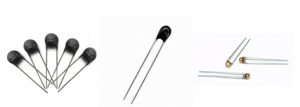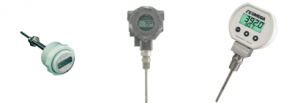A temperature transmitter is a device that connects a temperature sensor to transmit the signal for monitoring and control purposes. Typically, the temperature sensor is either RTD, Thermistor or Thermocouple type sensor and will interface with a PLC, DCS.
Temperature transmitter’s is to isolate the temperature signal, amplify and convert the temperature to a 4-20mA or 0-10V DC range for further use. The current signal 4-20 ma temperature transmitters are common in manufacturing as the majority of industrial equipment communicates via this signal range. The transmitted signal can be scaled inside the temperature transmitter to accommodate the needs of the application, e.g. the 4mA can be represent -17.7°C (0° Fahrenheit) and the 20mA can be represent 37.7° C (100° Fahrenheit).
Types of temperature transmitter.
RTD (Resistance Temperature Detector or Resistance Temperature Device) is one of the temperature sensors commonly used in industry today. Also commonly referred to as PT100, its resulting popularity is due to its accuracy and response at temperatures between -300 to + 600 ° F.The RTD comprises of a resistor that changes with temperature. The most common RTD by far is the PT100. This measures 100 Ohms at 0 degrees C (32 °F) and 138.5 Ohms at 100 °C (212.0 °F).

How does an RTD work?
RTDs works as the temperature of a metal increases, then theresistance of the metal increases. Similarly, the temperature of the RTD resistance element increases, the electrical resistance increase in ohms (Ω). RTD are commonly specified according to their resistance in ohms at zero degrees Celsius. The specification of RTD is 100 Ω, which means that at 0° C the RTD element should demonstrate the resistance of 100 Ω. Platinum metal is commonly used in RTD.
How the RTD output convert into 4-20 mA?
The form of signal transmission used in industrial instrumentation systems is 4-20 mA DC. This is analog signal standard, meaning that the electric current is proportionately represent measurements or command signals. Typically, a 4 mA current value represents 0% of scale and 20 mA current value represents 100% of scale, and any current value in between 4-20 mA represents a commensurate percentage in between 0% and 100%.
Sensors with a 4-20 mA current loop output are extremely common in control applications and industrial measurement. They have wide power supply requirements, and easy to deploy and generate a low noise output, and can be transmitted without loss over great distances. A RTD whose resistance changes with a change in temperature can be used in conjunction with a 4-20 mA Current Output RTD Temperature Transmitter to generate a current output.
Thermistor is a type of temperature sensor whose resistance is dependent on temperature, more so than in standard resistors. These are widely used as inrush current limiters, negative temperature coefficient or NTC and positive temperature coefficient or PTC.
Thermistors are of two opposite fundamental types:
1. NTC thermistors: These types of thermistors are defined as the resistance decreases as temperature rises. Andthese types of thermistors are commonly used as a temperature sensor, or in series with a circuit as an inrush current limiter.
2. PTC thermistors: These types of thermistors are defined as the resistance increases as temperature rises. And these types of thermistors are commonly installed in series with a circuit, and used to protect against overcurrent conditions, as resettable fuses.

Thermistors is differ from RTD in that the material used in thermistor is generally a polymer or ceramic, while RTDs use pure metals. The thermistors are in the form of rods, beadsand discs but RTDs are in different shapes and sizes. The temperature response is also different; RTDs are useful over larger temperature ranges, while thermistors typically achieve a greater precision within a limited temperature range, typically −90 °C to 130 °C.
How a Thermistor to Measure Temperature.
We know the thermistor is a resistive device and therefore according to Ohms law, a current is passing through it, a voltage drop will be produced across it. As a thermistor it is an active type of sensor that is it requires an excitation signal for its operation, any changes in resistance as the result of changes in temperature and it would be converted into voltage change.
V= IR
For example a 10kΩ thermistor with a series resistor of 10kΩ, then the output voltage at the temperature of 25 degree Celsius will be half the supply voltage.When the resistance of the thermistor changes due to change in temperature, the fraction of the supply voltage across the thermistor also changes producing an output voltage that is proportional to the fraction of the total series resistance between the output terminals.
Thus the potential divider circuit is an example of a simple resistance-voltage converter where the resistance of the thermistor is controlled by temperature with the produced output voltage is proportional to the temperature. So the more temperature in the thermistor gets, the lower the voltage.
Thermocouple is an electrical device consist of two dissimilar conductors forming electrical junctions at differing temperatures. It produces a temperature-dependent voltage as a result of the thermoelectric effect, and this voltage can be measure temperature. These are widely used as temperature sensor.
Commercially these are inexpensive, interchangeable, are supplied with standard connectors, and can measure a wide range of temperatures. Other type of temperature measurement, thermocouples are self-powered and require no external form of excitation. The limitation of thermocouples is precision; system errors of less than one degree Celsius (°C) can be difficult to achieve.
These are widely used in industrial applications include temperature measurement for gas turbine exhaust, diesel engines, and other industrial processes. This type of sensors are also using in homes, offices and industrial applications in thermostats, and also as flame sensors in safety devices for gas-powered appliances.

RTD & Thermocouple temperature 4-20 mA current transmitter.
Thermocouple:
• These are Input devices types J, K, T, E, N, R, S.
• User selectable spans from entire TC or RTD range down to 15.0°.
• All ranges factory calibrated.
• Output resolution: 0.025% of span (12 bits).
• DIN rail mount package only 22.5 mm thick.
• Detachable screw-clamp connectors.
• Optional dual solid state relays for alarm or control.
RTD:
• Input for 100 ohm platinum RTDs with DIN and ANSI curves.
• Upscale or downscale open sensor indication.
• 2, 20, 200 mA and 5A DC current ranges.
• Isolated 4-20 mA or 0-10V isolated transmitter outputs, selectable.
• Output update rate: to 60/sec.
• Powered by AC or DC.
• Easy setup using Laurel’s PC-based Instrument Setup Software.

